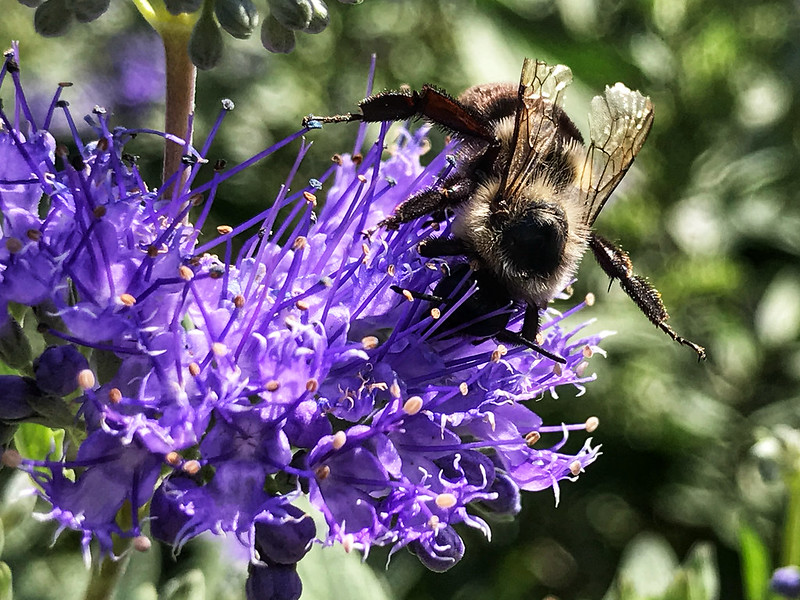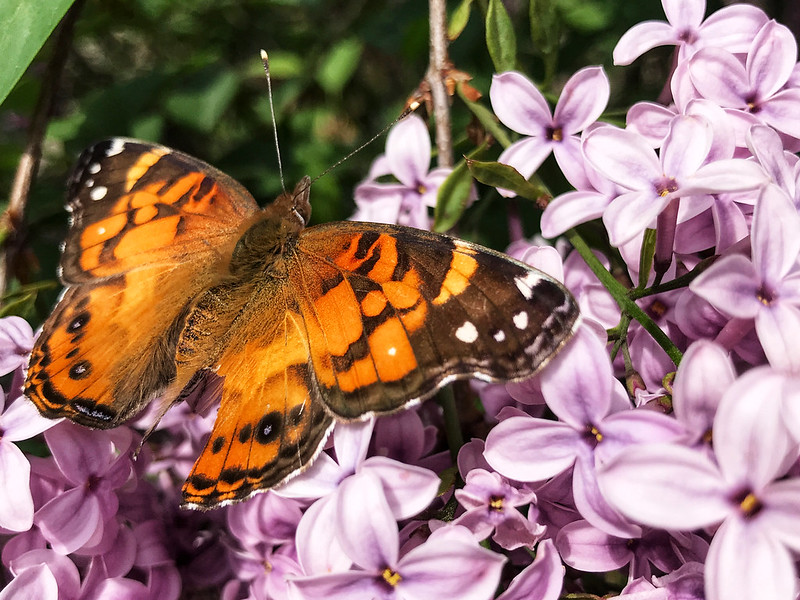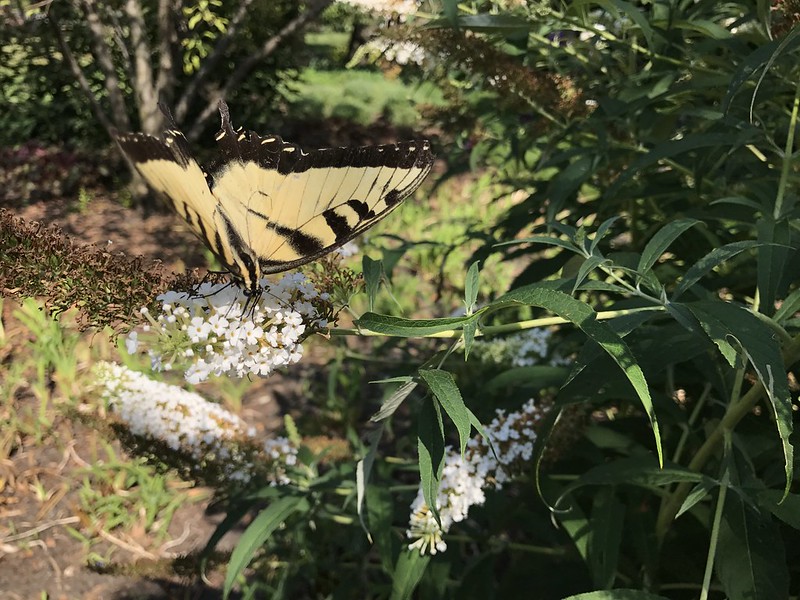June 17-23, 2019. Hug a pollinator today (gently).

Well, in September 2018 . . .

Before the tornado warnings started and the tornado sirens went off, I went for a morning bike ride, when it was still a sunny, pleasant, even perfect spring day. My main objective was lilac bushes. I love the scent of lilacs. They remind me of home, probably because a couple of lilac bushes at the front of the trailer park bloomed a few years.
When I got there, someone walking toward me caused a mini-swarm of insects to rise — many of them butterflies. Red admirals, American and possibly painted ladies, monarchs — well, one monarch, anyway. I managed to take some photos, although they were skittish, and I didn’t want to disrupt their breakfast too much — they must have tremendous energy needs just now.





1 Per Wikipedia:
It [red admiral] is known as an unusually people-friendly butterfly, often landing on and using humans as perches.
Last year I saw what seemed like dozens of Hemaris diffinis and H. thysbe moths around one of the butterfly bushes at Perennial Garden. This summer I’m seeing very few — mostly only one at a time. I’ve seen only one giant swallowtail, the first butterfly I noticed there on my way home from the farmers’ market. I haven’t seen one since.
At least I’m seeing monarchs, tiger and black swallowtails, red-spotted purples, several kinds of skipper, and a few hackberry emperors. I’m terrible at identifying trees, but several of the trees look like hackberry trees. The hackberry is to the hackberry emperor what milkweed is to the monarch — sole food for the caterpillar.
On August 11, a very pale hackberry emperor landed on my shirt and stayed until I had to start walking and gently shooed it off.

I say “pale” because hackberry emperors are usually darker.

Last week I was about to walk my bike through the grass from one bush to another when a hackberry emperor landed on my arm. It proceeded to probe about with its proboscis. It went at it for several minutes, even after I started walking again, arm raised in an awkward position. After a few moments it flew off.
Assuming it was sucking up sweat, I looked up the behavior, called “puddling.”
By sipping moisture from mud puddles, butterflies take in salts and minerals from the soil. This behavior is called puddling, and is mostly seen in male butterflies. That’s because males incorporate those extra salts and minerals into their sperm.
When butterflies mate, the nutrients are transferred to the female through the spermatophore. These extra salts and minerals improve the viability of the female’s eggs, increasing the couple’s chances of passing on their genes to another generation.
What could be more charming than knowing your sweat will help produce more hackberry emperors? I may not have children and grandchildren, but I will have butterflies!
During the first half of August last year, I was thrilled to discover not only butterflies at Perennial Garden, but also the little fairy moths known as snowberry clearwings (Hemaris diffinis). I never expected to see anything like them here.
I found that great, Eastern tiger, and black swallowtails; red-spotted purples; painted ladies; silver-spotted and fiery skippers; bees; clearwings; and even a hummingbird or two love a particular butterfly bush at the garden. This bush, which had been cut down to the ground after last summer, didn’t bloom fully until early to mid-August — I started checking as early as May! On my brief visits, I never saw clearwings, so I braced myself for disappointment.











I started seeing a few clearwings a couple of weeks ago Thursday. When I pedaled over the Saturday before last at 3 p.m., the bush was swarming with life. I noticed that among the snowberry clearwings a few hummingbird clearwings, with their fuzzy green upper backs, were making an appearance. I was in heaven. I love these guys — even after I noticed they were buzzing one another and throwing each other off choice branches or blossoms.


By Saturday there were fewer of the snowberry clearwing moths under the increasingly cloudy skies. I was happy to have seen so many the day before.
I’d made one of the photos I’d taken the background image on my iPhone screen. I’ve changed phones since then, but I haven’t changed the image. I took a closer look at it — and realized that particular photo from last year is of a hummingbird moth (Hemaris thysbe). How did I never notice that? It had the species’ distinctive fuzzy green upper back and lacks the light band near the skirt. While bemoaning that I hadn’t seen any Hemaris thysbe at this butterfly bush, I’d been staring at a photo of one I’d taken a year ago. Brilliant.

Last Tuesday I left work early for a doctor’s appointment and managed to get to the garden by 5 p.m. I was happy to have this unexpected opportunity to visit my little fairy moths — especially since they live only a few weeks.
The bush wasn’t buzzing like it’d been on Saturday, and there weren’t any large butterflies around—but there were enough moths for me to get a few photos and videos, including one in slow motion. I don’t know why I didn’t think of that sooner, except I am still trying to get a sharp closeup photo.
While I was standing watching a handful of moths flitting around, I heard a “bzzzzzzzzt” behind my head. I turned to find myself face to face with a hummingbird, separated by only a foot and a half or two feet of space.
As I was trying to get myself together (“Where’s the phone? Where’s the camera app?”), she buzzed around me to take a couple of quick sips at the bush. I have only these mid-distance shots and a memory now.


Now there’s only about an hour between the time I get home, change, get my bike out, and ride over, and sunset. By that hour, the Hemaris moths are few if any. The other day I was watching a hummingbird clearwing when a snowberry clearwing attacked it and carried it away.
I wish I could tell them there are plenty of blossoms to go around for the little time they have left.